It’s Not Just Their Furry Feathered Feet!
The Brahma chicken is a dual-purpose breed that was originally developed in the United States but came to the UK in the 1950s. From there, it was distributed all over Europe… and it also found its way to Spain, where we live.
I first encountered the Brahma chicken breed when a local friend told us about his new chickens – the “King of All Poultry”, he said. He wasn’t joking. His Brahmas looked absolutely regal, with their pretty colors and the feathers on their feet.
In August 2016, we needed some company for a lonely chicken, and our friends were gracious enough to give us two Brahmas – Ramon and Ramona. Yes, we give our chickens names – especially when they’re here to stay and lay eggs for the remainder of their lives.
Six months later, we were able to add a few Brahma eggs to our incubator, and only 22 days later, out came lots of tiny fluffy Brahma chicks with tiny fluffy feathery feet. We managed to sell a few, ate the roosters (when they were fully grown), and the rest are here to stay. Ramona now has company from Queenie, and two yet-to-be-named Brahma chickens, as well as Caramel, who’s a half-breed (a daughter of Ramon and our brown layer Fatima).
So why do we love Brahma chickens so much, you ask? It’s not just because they’re pretty.
History of the Brahma Breed
The ancestry of the stately feather-footed Brahma chicken dates back to India and China; however much of their development as a meat breed is attributed to the United States during the mid-to-late 1850s. Although the name Brahma was derived from the Brahmaputra River in India, the birds were previously known by a succession of assorted names.
Selectively bred in China to create a large feather-footed chicken, the Brahma originated as a deliberate cross between the very tall Malay and the Cochin chickens, known for the excessive plumage covering their legs and feet as well as their capacity to lay large tinted eggs well through the winter.
Chicken breeders in Shanghai, China then imported the Malay-Cochin cross and gave them the name “Shanghai.” Subsequently, they were crossed with India’s Gray Chittagongs, which were known for the pea comb and beetle brow that is noticeable in today’s Brahma. As the Brahmas developed, they took on a variety of names, the most common including Chittagong, Gray Shanghai, and Brahma Pootra. Finally, after transport to the UK, the name was shortened to simply “Brahma.”
Upon further transport to the United States, the Brahma developed into its own breed, with offshoots being the Dark, Light, and finally the Buff variety.
Today’s standard Brahma weighs between 8-12 pounds (about 4-5 kilos), a bit larger than the average chicken. They are known as beautiful, large, and dignified birds, a chosen favorite for shows and country estates. They live between 5-8 years.
What’s So Special About Brahma Chickens?
Brahmas have quite a lot to offer. Characteristics include:
- Extremely friendly and relaxed – and easy to care for
- Hardy, steady layers.
- Good meat birds.
- Bigger, although not ridiculously big. Those HUGE birds in videos are either a genetic fluke or a hoax!
- Feathered fluffy furry feet.
- Hens are traditionally good sitters (broody hens), as well as good mothers.
#1 – Brahmas are Friendly and Relaxed
Brahma chickens are super relaxed birds. We notice the difference when they’re still tiny chicks – some other breeds are much louder or even panic when we pick them up, while Brahmas will just settle in your hand and wait for whatever you have in store for them.
And it goes on as they grow older. Brahmas wouldn’t hurt a fly (except maybe probably, a real fly). They’re the most docile birds we’ve had around… even the roosters are in no way frightening, ever. So far, all of our Brahmas were very friendly towards other chickens as well – there are always exceptions to the rule though, so don’t hate me if you get an antisocial killer Brahma.
#2 – Brahmas are a Dual Chicken Breed!
Brahmas are dual chickens – which means they’re good for both meat and eggs.
The advantage to that is very simple: we incubate eggs and raise the chicks, and when the time comes, we keep the hens for eggs, and the roosters become food. In the past, when butchering roosters from “normal” egg-laying breeds, they often didn’t have much meat on their bones – while hens from meat breeds are rubbish at providing our home with daily fresh eggs.
#3 – Brahma Chickens are (Often) Good Broody Hens
At least half of the chickens of our Brahma-keeping friends seem to become broody in spring.
It’s not the case with ours… but each year, one or two of our Brahma (or Brahma cross) hens feel good enough to become broody and raise a new generation of chicks.
#4 – Brahma Hens are Consistent Layers
Our Brahma ladies lay consistently, even when the days get shorter and starting again long before spring shows its nose – only taking a small break in the dead of winter when everybody’s just miserable and hoping for a bit more sun.
#5 – Brahma Roosters are Good-Sized Meat Birds
Our Brahma roosters either get sold or end up on the dinner table. One rooster is about as big as the average pumped-up meat chicken you’d buy in the supermarket. The difference is our boys had a fabulous life between the Spanish almond trees, scratching for bugs and eating table scraps. They taste far superior to any chicken we ever got from a shop.
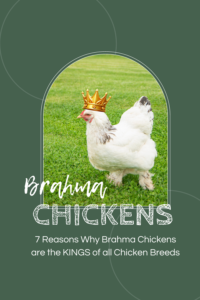
#6 – Brahma Chickens are Pretty!
Yes, it does count. While I’m not a huge fan of the feathers on their feet (except on the babies – did I mention baby chicks with feathery fluffy feet?), they do have the prettiest color combinations, and they walk in such a regal way.
Even the hybrids are pretty – we had several babies from our rooster Ramon and our brown egg layer Fatima (we only kept Caramel, who looks like Auntie Calimero). They have feathers on their feet but not as many, and there’s a bit more life in them than in full Brahmas. Or to read between the lines: the roosters were absolute bastards. Literally, and figuratively. But they were so pretty too!
Brahmas might well be the kings and queens of chickens.
#7 – Brahmas are Big!
Brahma chickens are a BIG breed. Not usually as big as the videos that circulate will have you believe (some of them just have smaller accessories to make the birds appear bigger on screen, and some of them just have giant Brahmas), but big nonetheless. They’re great egg layers, but they eat at least their part as well.
Make sure there’s space for them in your chicken run. More than once have we seen a future Brahma owner reconsider their ideas after seeing ours – just because the run wouldn’t allow them to stand up straight, or they wouldn’t fit through the chicken door.
Their size makes Brahma chickens easy to handle – and quite majestic to look at.
Brahmas aren’t Perfect for Everyone…
However, there may be reasons why even the kings and queens of chickens aren’t the right fit for your chicken palace.
– Brahmas Take a Long Time to Mature
Brahmas are slow growers, which is probably the reason why not EVERYBODY has them. It just takes a long time before they’re fully grown, and ready to start laying their first egg at 6-7 months. For comparison, most modern, egg-laying breeds start laying at 4-5 months.
– Brahma Roosters are (Often) Rubbish
Did I mention Brahma roosters are super friendly? That’s true. They’re a bit too friendly though. I’ve never seen a Brahma rooster protect his flock from a visiting dog or fox.
Besides, if you have a mixed flock, Brahma roosters might well be a bit too big. We have a few Bantam (smaller chicken breeds) in our flock, and just imagining a big Brahma rooster on top of that… it’s just too much.
– Brahma Feet Feathers get Sticky in the Mud
Our soil is very close to clay, which makes it a very muddy and sticky business just after it rains. With most of our chickens, that’s not a problem; the mud will dry and they’ll lose the clumps of clay as they run and scratch around.
Not so much with our Brahma chickens – the clumps of clay often stick to their feathers. It does fall off eventually, it just doesn’t look very comfortable. Of course, this is not an issue if you have your chickens free-ranging on some fresh green grass or in the forest – it’s also one of the main reasons why we move our chickens to rotate pastures every year in the fall.
– Brahmas are Slow and Can’t Fly
It’s a pro for some, a con for others: while their being fat and slow makes Brahma chickens easy to catch (and more fun for small children)… it makes them easy to catch (for foxes, neighborhood dogs, etc). More than once have we seen our Brahmas being the first victims of an attack – while other chickens went to perch somewhere higher up.
Frequently Asked Questions about Brahmas
Are Brahma Roosters Aggressive?
Brahma cockerels, despite their larger size, are unfortunately not great for protection against predators. In terms of protecting the flock, these roosters are simply too friendly, too plump, and too clumsy.
On the upside, very few Brahma boys are aggressive towards people. And if they do, there are ways to turn them “back to normal.”
As far as their peers, these male Brahmas are actually more tolerant towards other roosters than most other breeds I’ve encountered, but that doesn’t make them impassive: they still don’t like other roos.
Please note that this is based on my own experience, raising a couple of dozen Brahma chickens & roosters from just a handful of different lines, speaking about them with fellow Brahma owners, and reading about them on the internet. Temperament can be a lottery: if you happen to get an aggressive Brahma rooster, it’s likely their male relatives will display similar behavior.
When Do Brahmas Start Laying Eggs?
Brahma hens will begin laying eggs somewhere between six and nine months of age, which is a good eight weeks later than most other breeds.
What Color Eggs Do Brahmas Lay?
Brahma hens are known for laying tinted eggs: a lovely light brown. In my own experience, their eggs are often longer (less round) than the typical chicken egg.
Can You Eat Brahma Chickens?
If you’re looking for a breed of chickens that lay eggs as well as produce meat, you’ll be happy to know that you can indeed eat Brahmas. The meat is quite tasty, although you’ll have to wait for them to mature. At 13 weeks, they’re plump enough to be eaten, but I would advise you to wait until they’re about eight months old. By that time, they’ll have plenty of meat on them.
Of course, the older they get, the more creative you’ll want to get with cooking methods – I can tell you that we’ve eaten a rooster once at around 15 months, and it was rather delicious in this beer can chicken recipe.
What Is the Difference Between a Cochin and a Brahma Bantam?
The word “bantam” means a chicken of a small breed, thus accordingly today’s Brahma Bantam is a small version of a Brahma. Today’s Cochin, also with feathered feet, is quite similar and comes in a wider variety of colors.
People seem to be partial to each breed, claiming that one is more docile than the other. Seems you can’t go wrong with either a Brahma Bantam or a Cochin.
Do Brahma Chickens Have Any Breed-Related Health Issues?
Brahmas don’t really have any problematic health issues. Occasionally their feathered feet can get clumped up with mud, but they’re pretty good at cleaning their own feet. Best, however, to keep an eye on them just in case.
On the Fence about Raising Brahmas?
Brahmas have been nicknamed the “King of all Breeds”. I always have two or three of them in my flock; I like that they’re dependable and funny to look at. I’m less charmed by their non-existing defense mechanism; whenever predators wreaked havoc in the past, the Brahmas were the first (sometimes the only) to go.
If you’re still on the fence about getting some feathered friends for yourself, check out our post that mentions some of the pros and cons of keeping chickens.
Tell me – do you have Brahma chickens, or have you had them in the past? Do you agree with others calling them the “king of all breeds”, or would you like to nominate a different chicken breed for that?

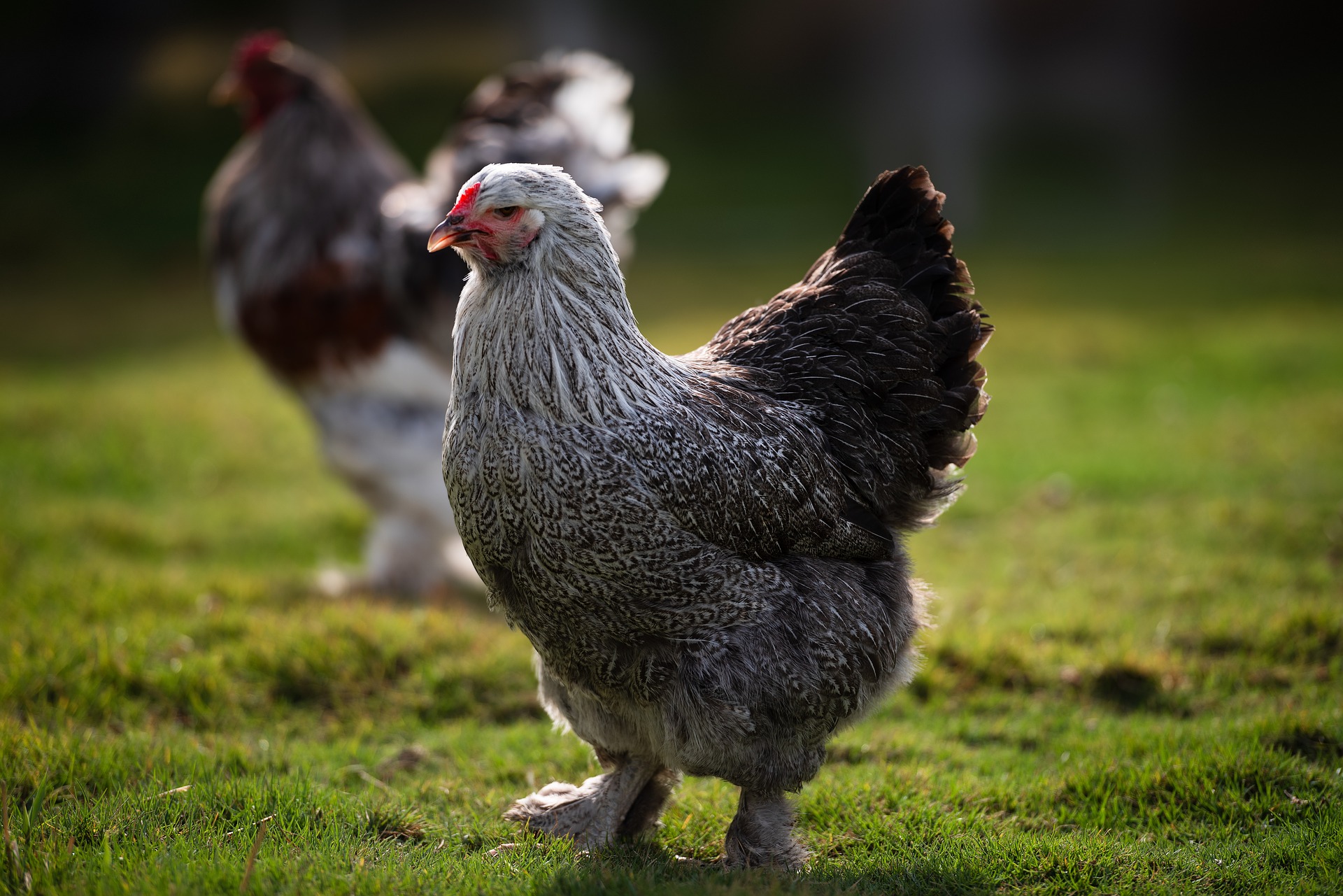
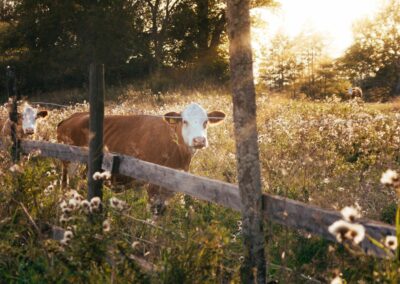
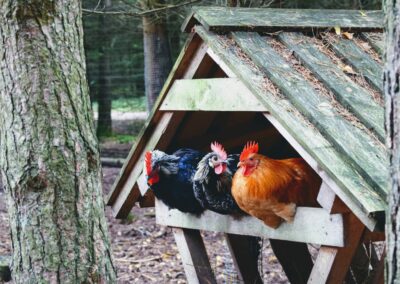
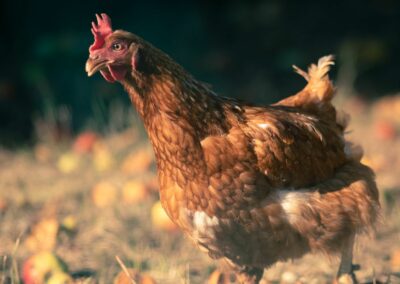
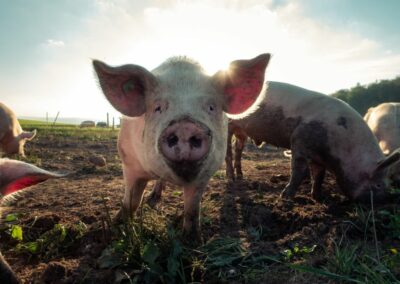
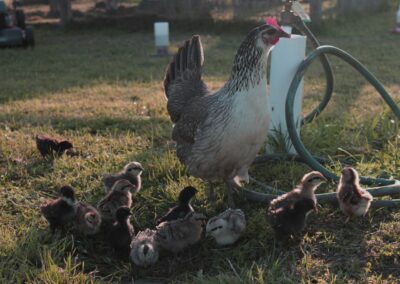
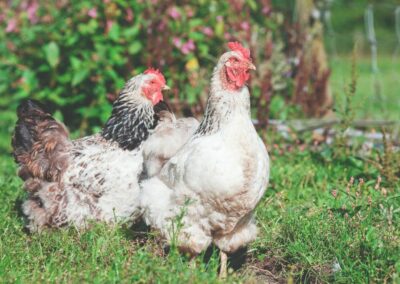
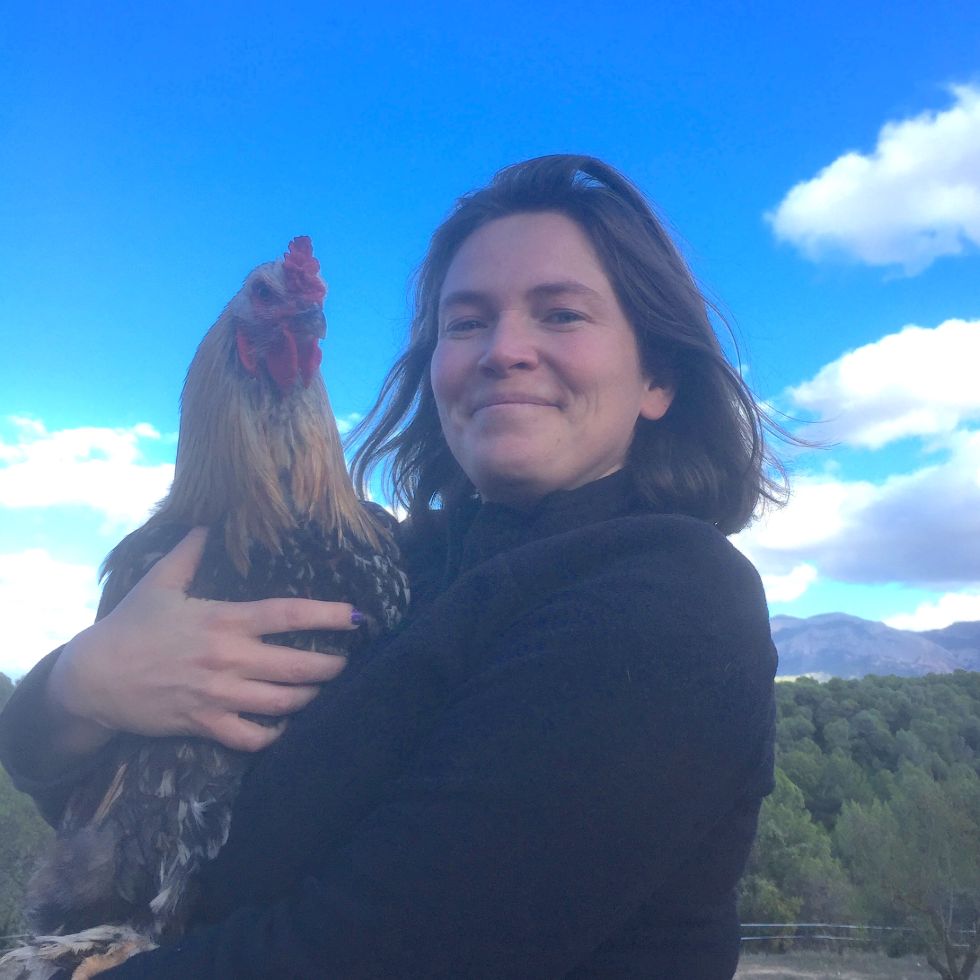
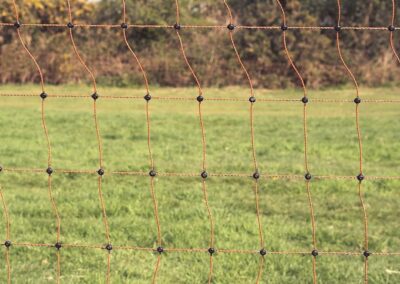
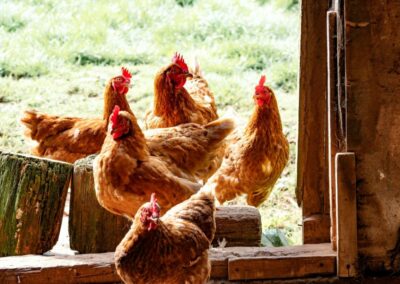
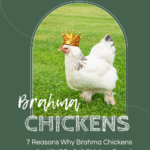
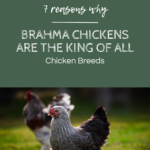
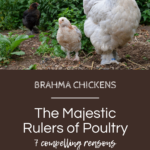
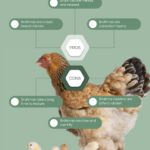
I picked out a Bhrama by mistake (how could I miss those feathered feet?!?l and as Edith Roosevelt reaches here 4th month, her sweet regard is quickly notching her in my heart as my favorite chicken. I really appreciate this article. the information you have provided is very helpful! Thank you!
it started laying late at the age of 8-9 months in my observation and also cited on http://www.thechickenpet.com
Yes I had a Brahma that will forever hold a special place in my heart. Thank you for sharing!
I love my Brahmas because they are gentle giants; a bit shy but at first but eventually, will be eating from my hand. They come in amazing, beautiful colors. I have barnyard mixes and pure breed Brahmas. My Brahma roos don’t attack me but they do fight with each other during breeding season. The sweetest roo will be a bit aggressive towards me when protecting his mate and chicks but once he leaves the breeding cage, he will be back to following me around like a dog. Any roosters from other breeds that I have raised become aggressive and territorial once they reach breeding age; even those sweet little Cochins and they don’t revert back. Those that won’t stop attacking me have to be re-homed. I do have to be more vigilant with putting them up at night and watching them a bit more closely when they are free ranging. They don’t seem to know how to protect themselves and forget that that they can fly 8 feet up to their roosting poles. I keep a few roosters from breeds known for being good flock protectors with my them while they free range. I enjoy my gentle giants very much and would encourage anyone to get Brahmas especially if they have little kids : )
My big Brahma boy used to be nasty towards his sons when they grew too big! But he’d be absolutely useless against a stray dog or other predators. I kept one of the sons though (George Cookelooney) and he’s the opposite – I was able to keep him with another rooster for years and when danger looms, at least he tries. He’s the best cuddly roo ever too!
how do I take of it, when is starting laying eggs
Not sure what you mean…
But if you have a hen that’s sitting on the eggs, you might want to check out this article: https://sunnysimpleliving.com/hatching-eggs-raising-chickens/ – there’s a part about “how to break a broody hen”.
I love my Brahmas! very sweet and special! I have had my girls for 3 years now. Just got 3 more and a roo. Excited to see him grow up! First time roo owner